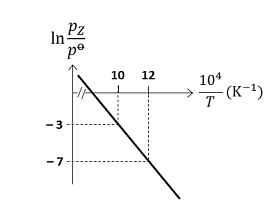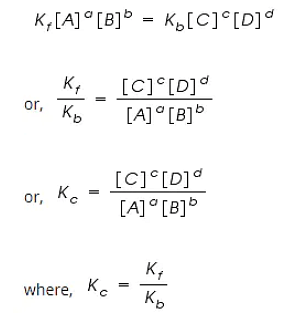For the reaction, $X (s) \rightleftharpoons Y (s)+ Z (g)$, the plot of $\ln \frac{p_{ Z }}{p^{0}}$ versus $\frac{10^{4}}{T}$ is given below (in solid line), where $p_{ z }$ is the pressure (in bar) of the gas $Z$ at temperature $T$ and $p^0=1$ bar

(Given, $\frac{ d (\ln K)}{ d \left(\frac{1}{T}\right)}=-\frac{\Delta H^{0}}{R}$, where the equilibrium constant, $K=\frac{p_{z}}{p^{0}}$ and the gas constant, $R=8.314 \,J \,K ^{-1} mol ^{-1}$ )
The value of $\Delta S^{0}$ (in $J\, K ^{-1} mol ^{-1}$ ) for the given reaction, at $1000\, K$ is ______

(Given, $\frac{ d (\ln K)}{ d \left(\frac{1}{T}\right)}=-\frac{\Delta H^{0}}{R}$, where the equilibrium constant, $K=\frac{p_{z}}{p^{0}}$ and the gas constant, $R=8.314 \,J \,K ^{-1} mol ^{-1}$ )
The value of $\Delta S^{0}$ (in $J\, K ^{-1} mol ^{-1}$ ) for the given reaction, at $1000\, K$ is ______
Correct Answer: 141.34
Solution and Explanation
The equation that relates the standard Gibbs free energy change (\(\Delta G\degree\)), the enthalpy change (\(\Delta H\degree\)), and the entropy change (\(\Delta S\degree\)) is:
\(\Delta G\degree=\Delta H\degree-T\Delta S\degree.....(i)\)
where T is the temperature in kelvin and R is the gas constant.
The equation that relates the equilibrium constant (K) and the standard Gibbs free energy change is:
\(\Delta G\degree=-RT\ In(K).....(ii)\)
We can combine these two equations to eliminate ΔG° and solve for K.
Given that \(K=\frac{p^2}{p\degree}\) and P° = 1 bar
\(ln(\frac{P}{1}) = \frac{-\Delta H\degree}{RT} + \frac{\Delta S\degree}{R}.....(iii)\)
The slope of the graph in the image is equal to \(\frac{-\Delta H\degree}{R}\).
Slope = \(10^4(\frac{Y_2-Y_1}{X_2-X_1})=10^4(\frac{-7+3}{12-10})=-2\times10^4\)
We can use the gas constant value (R = 8.314 J/mol*K) to find ΔH°.
\(-2\times10^4=\frac{\Delta H\degree}{R}=\gt2\times10^4\times8.314\)
\(\Delta H\degree=166280Jmol^{-1}=166.28kJ\ mol{-1}\)
We can also use the graph to find the temperature (T) at which the pressure is 10^7. The temperature is 10^3 K.
We can substitute the values of ΔH° and T into equation (iii) to solve for ΔS°.
\(ln(\frac{P}{1}) = \frac{-\Delta H\degree}{RT} + \frac{\Delta S\degree}{R}\)
\(-3 = -\frac{2\times10^4\times R}{R\times 10^3} + \frac{\Delta S\degree}{R}\)
\(\frac{\Delta S\degree}{R}=20-3=17\)
\(\frac{\Delta S\degree}{R}=17\times R=17\times8.314=141.34JK^{-1}\ mol^{-1}\)
So, the correct answer is \(141.34JK^{-1}\ mol^{-1}\)
Top Questions on Law Of Chemical Equilibrium And Equilibrium Constant
- For the reaction $ N_2 + 3H_2 \rightleftharpoons 2NH_3 $, if initially 1 mole of $ N_2 $ and 3 moles of $ H_2 $ are taken and at equilibrium 0.4 moles of $ NH_3 $ are formed, find the equilibrium concentration of $ H_2 $.
- BITSAT - 2025
- Chemistry
- Law Of Chemical Equilibrium And Equilibrium Constant
- Consider the equilibrium: \[ \text{CO(g)} + \text{3H}_2\text{(g)} \rightleftharpoons \text{CH}_4\text{(g)} + \text{H}_2\text{O(g)} \] If the pressure applied over the system increases by two fold at constant temperature then:
- JEE Main - 2025
- Chemistry
- Law Of Chemical Equilibrium And Equilibrium Constant
The equilibrium constant for decomposition of $ H_2O $ (g) $ H_2O(g) \rightleftharpoons H_2(g) + \frac{1}{2} O_2(g) \quad (\Delta G^\circ = 92.34 \, \text{kJ mol}^{-1}) $ is $ 8.0 \times 10^{-3} $ at 2300 K and total pressure at equilibrium is 1 bar. Under this condition, the degree of dissociation ($ \alpha $) of water is _____ $\times 10^{-2}$ (nearest integer value). [Assume $ \alpha $ is negligible with respect to 1]
- JEE Main - 2025
- Chemistry
- Law Of Chemical Equilibrium And Equilibrium Constant
- In the following system, $ PCl_5(g) \rightleftharpoons PCl_3(g) + Cl_2(g) $ at equilibrium, upon addition of xenon gas at constant T and p, the concentration of
- JEE Main - 2025
- Chemistry
- Law Of Chemical Equilibrium And Equilibrium Constant
- Given below are two statements:
Statement I: A catalyst cannot alter the equilibrium constant ($ K_c $) of the reaction, temperature remaining constant.
Statement II: A homogeneous catalyst can change the equilibrium composition of a system, temperature remaining constant.
In the light of the above statements, choose the correct answer from the options given below.- JEE Main - 2025
- Chemistry
- Law Of Chemical Equilibrium And Equilibrium Constant
Questions Asked in JEE Advanced exam
Let $ a_0, a_1, ..., a_{23} $ be real numbers such that $$ \left(1 + \frac{2}{5}x \right)^{23} = \sum_{i=0}^{23} a_i x^i $$ for every real number $ x $. Let $ a_r $ be the largest among the numbers $ a_j $ for $ 0 \leq j \leq 23 $. Then the value of $ r $ is ________.
- JEE Advanced - 2025
- binomial expansion formula
- The total number of real solutions of the equation $$ \theta = \tan^{-1}(2 \tan \theta) - \frac{1}{2} \sin^{-1} \left( \frac{6 \tan \theta}{9 + \tan^2 \theta} \right) $$ is
(Here, the inverse trigonometric functions $ \sin^{-1} x $ and $ \tan^{-1} x $ assume values in $[-\frac{\pi}{2}, \frac{\pi}{2}]$ and $(-\frac{\pi}{2}, \frac{\pi}{2})$, respectively.)- JEE Advanced - 2025
- Inverse Trigonometric Functions
Let $ \mathbb{R} $ denote the set of all real numbers. Then the area of the region $$ \left\{ (x, y) \in \mathbb{R} \times \mathbb{R} : x > 0, y > \frac{1}{x},\ 5x - 4y - 1 > 0,\ 4x + 4y - 17 < 0 \right\} $$ is
- JEE Advanced - 2025
- Coordinate Geometry
The center of a disk of radius $ r $ and mass $ m $ is attached to a spring of spring constant $ k $, inside a ring of radius $ R>r $ as shown in the figure. The other end of the spring is attached on the periphery of the ring. Both the ring and the disk are in the same vertical plane. The disk can only roll along the inside periphery of the ring, without slipping. The spring can only be stretched or compressed along the periphery of the ring, following Hooke’s law. In equilibrium, the disk is at the bottom of the ring. Assuming small displacement of the disc, the time period of oscillation of center of mass of the disk is written as $ T = \frac{2\pi}{\omega} $. The correct expression for $ \omega $ is ( $ g $ is the acceleration due to gravity):

- JEE Advanced - 2025
- Waves and Oscillations
- Consider the vectors $$ \vec{x} = \hat{i} + 2\hat{j} + 3\hat{k},\quad \vec{y} = 2\hat{i} + 3\hat{j} + \hat{k},\quad \vec{z} = 3\hat{i} + \hat{j} + 2\hat{k}. $$ For two distinct positive real numbers $ \alpha $ and $ \beta $, define $$ \vec{X} = \alpha \vec{x} + \beta \vec{y} - \vec{z},\quad \vec{Y} = \alpha \vec{y} + \beta \vec{z} - \vec{x},\quad \vec{Z} = \alpha \vec{z} + \beta \vec{x} - \vec{y}. $$ If the vectors $ \vec{X}, \vec{Y}, \vec{Z} $ lie in a plane, then the value of $ \alpha + \beta - 3 $ is ________.
Concepts Used:
Law of Chemical Equilibrium
Law of Chemical Equilibrium states that at a constant temperature, the rate of a chemical reaction is directly proportional to the product of the molar concentrations of the reactants each raised to a power equal to the corresponding stoichiometric coefficients as represented by the balanced chemical equation.
Let us consider a general reversible reaction;
A+B ↔ C+D
After some time, there is a reduction in reactants A and B and an accumulation of the products C and D. As a result, the rate of the forward reaction decreases and that of backward reaction increases.
Eventually, the two reactions occur at the same rate and a state of equilibrium is attained.
By applying the Law of Mass Action;
The rate of forward reaction;
Rf = Kf [A]a [B]b
The rate of backward reaction;
Rb = Kb [C]c [D]d
Where,
[A], [B], [C] and [D] are the concentrations of A, B, C and D at equilibrium respectively.
a, b, c, and d are the stoichiometric coefficients of A, B, C and D respectively.
Kf and Kb are the rate constants of forward and backward reactions.
However, at equilibrium,
Rate of forward reaction = Rate of backward reaction.

Kc is called the equilibrium constant expressed in terms of molar concentrations.
The above equation is known as the equation of Law of Chemical Equilibrium.